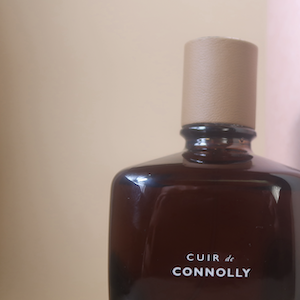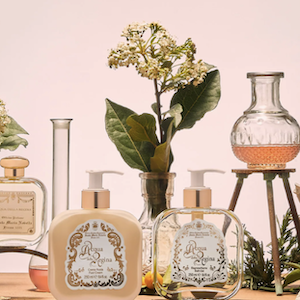Fix It
By Jo Phillips
Creating perfume is an art form, something that takes enormous talent, skill, and know-how in order to build a beautiful scent. Dizzying in most of our minds, is the craft of making a fragrance; it’s no wonder some of the greatest noses are seen as demigods. But it is really also based within science. Whilst sublime oils are balanced expertly by a nose to create just the exact balance for the desired scent the skill goes way past mixing and balancing. The bottom line is that each note added will not just bring a new facet or change the scent it will affect the blend and longevity and that is why science and art meet in perfumery, Read more about how an ingredient will expand a scent here in Fix It!
All images in Fix It, Jason Yates, creative direction Jo Phillips with thanks to Sadie
Firstly, and most importantly, some essential oils used in perfumery are not stable like a piece of wood but ephemeral and delicate and they need to be treated with care and love; but most importantly understood as to what their whole value and effect may well be to a perfume.
It’s not just about how, say, two different scents may go together as mixing with each other will change both originals, but the power as to how of each will alter the balance and the longevity of the overall scent.
This is a key reason why perfume is talked of in top, middle, and base notes. The top notes are usually the most delicate with the least longevity to them with the base notes being the exact opposite.
Base notes are used most often to wrap up the final silage (the scent trail if you like) but also to enhance other items within, give them a longer life and staying power.
So certain key ingredients in fragrance are used not just for their beauty, lingering silage but also to what in a very simple way we may call, an almost explosive effect on the whole of the perfume. Generally, these are referred to as fixatives. Animal substances were often used (in days gone by not anymore) as fixatives that enable perfume to evaporate slowly and emit odours longer.
A fixative, in simple terms, is there in a perfume to hold the scent in place for longer, give it more ‘bite’ more tenacity. Also to ‘even’ out the different volatilities of ingredients. As some perfume notes evaporate much quicker than others. A fixative will slow down the evaporation rate meaning the change we experience in a fragrance becomes a slow and meaningful journey.
So fixatives in scent smell wonderful but create a chemical reaction as such, to improve the wearing experience of the fragrance journey. And this is why at the cornerstone of any perfume-making, science is the key; the key that unlocks the mystery and beauty. So when we talk of science being part of perfume making it means someone with a specific set of knowledge who knows where this art and science meets.
Some fixatives of course are made in the lab, synthetic versions, but there is quite a large selection of natural note out there too. These notes with fixative characteristics are routinely used to extend the life of short-lived ingredients and are mostly found in the base of the perfume. The notes most volatile are at the top and the more we go down the perfume pyramid the more longer and most stable the items.
Think of it a little like this, base notes are part of the formula a prominent feature rather than something added to increase the life of an existing formula, working as a seamless part of the blend.
Not every perfume you smell will have natural fixatives some will be synthetic versions but here we celebrate just a few of the scents with these magic elements in them. Juicy, rich, and explosive the very elements of exquisite scent.
Angelica
It is used as a flavoring in liqueurs, for foods and jams for centuries. The long bright-green stems have been candied and used for food decoration. Yet it is also known for its aromatic odor, with both the root and the seeds used. It has a green, odoriferous odor with other facets particularly herby also present think fennel, parsley, anise, caraway, and can also have musky or even juniper edge to it.
Image on left-hand side Atelier Cologne Jasmin Angélique. A walk in beautiful twilight find Jasmine, lemon and angelica. A floral fragrance that is delicately fresh and luminous.
Sandalwood
Sandalwood is a deep, woody scent and often smells like a mix of floral, rich, balsamic, soft, and sweet accents. Because of its great scent, it is often used a base note in many iconic perfumes and colognes. It is often described as creamy, as well as earthy, rich and exotic.
The amazing thing about Sandalwood is, even though it has its own soft, subtle notes, it works wonderfully as a carrier for other aromas. When blended with other woody or earthy scents, it creates an uplifting fragrance with a real depth.

Guerlain Mon Bloom of rose, the signature floral notes of Mon Guerlain include Sambac Jasmine and Carla Lavender combined with Neroli and Rose to form a radiant and lively fragrance.
Chanel Coco Noir, with an accord of Egyptian Jasmine and May Rose, magnetic notes of Patchouli and Tonka Bean, along with the more pronounced notes of Bourbon Vanilla and New Caledonian Sandalwood
Vetyver Chantecaille a dry, subtly woody scent is punctuated by the pinelike Juniper, find Citron, Pepper, Nutmeg, and Bergamot. Spicy, sexy hints of Musk and Sandalwood give Vetyver an alluring quality.
Orris
Wonderful Orris, sweet, soft, powdery, suede-like rather like violets, it comes from the root of the iris and runs the spectrum from sweet to earthy: Yet this powdery aroma can also be reminiscent of suede or even freshly-baked bread. One of the most majestic ingredients in scent.

Tom Daxon Iridium, powdery sophistication from the precious iris concrete but with a strong silvery spine including Juniper, Angelica, Carrot Seed Iris, Vetiver, Cedarwood, and bewitching Iso E Super.
Love in Black Creed, Blackcurrant buds and Clove cut through the floral sweetness with a sharp peppery note which develops into the luxurious powderiness of costly Florentine Iris blended with Rose. The base is a rich melange of woods, Tonka and aromatic resins.
Amber Kiso DS & Durga at E-scents Amber Kiso boasts a rare and woody scent. Japanese Cedar, incense, and Cypress slice through the air of Patchouli and Iris, glancing off leather Bushi armor to release the magnifgicent Hinoki and tree moss

Maison Francis Kurkdjian Amyris Homme, A luminous eau de toilette, born from the flamboyant encounter between the Amyris tree from Jamaica and rare Florentine Iris, including notes Mandarin oil, Rosemary oil, Saffron accord, Iris oil
Amyris oil, Cedarwood oil and Tonka bean absolute Maison Francis Kurkdjian Amyris Femme with the same inspiration as the mens this has notes of Lemon blossom, Pear accord, Sweet pea accord, Iris oil and Amyris oil.
Patchouli
Seen by so many as the smell of the 1970’s hippy, it is a very important ‘fix it’ facet. This infamous oil has a characteristic scent that might be described as woody, sweet, and spicy. Patchouli has a strong, sweet scent that falls into the musky-earthy category. While it’s part of the mint family, patchouli doesn’t smell fresh and cool, Instead, it smells sweet, spicy and musky.

Maison Francis Kurkjdian Masculin Pluriel, with Grapefruit, Lemon, Lavender absolute, Soft leathery accord
Cedarwood and Patchouli. Floral Street Chypre Sublime, damask Rose, Violets, Patchouli, and Geranium tap with Olibanum and a resin-soaked wooden table for the flowers to perch on. Tom Daxon Resin Sacra. Suede, Frankincense, Patchouli, Benzoin Siam, Cistus, Sandalwood, Vetiver

Storie Veneziane Blu Cobalto I, Patchouli woody, earthy, deep, mysterious essence of the broad wake with cocoa extract, Apoponaco (absolute) a balsamic note of Vanilla, Amber.
Guerlain Patchouli Ardent a woody floral by Guerlain’s Master Perfumer Thierry Wasser. A raw material usually darkly woody and mysterious, used here in a surprisingly vibrant and bright way. It combines the elegance of Rose with a majestic Leather and Musks accord to offer a unique sensorial voyage.
Vanilla
Soft creamy sweet and even a little rum-like. In the early 1990s, perfume makers began to introduce vanilla as a significant note in fragrances. Yet is again is used as a ‘fit it’ ingredient. Now, a dominant ingredient in a large number of scents., it is the Vanilloids in it that makes it so powerful. These Vanilloids are also to be found in cocoa, allspice, cinnamon, cloves, ginger, they work to ‘hold open’ our vanilla receptors, slowing down the process giving us more time to perceive, experience and enjoy both scents and flavours.

Parfums de Marly Delina, structured with Turkish Rose, Lily of the Valley and Peony with a fruity trio of Lychee, Rhubarb and Bergamot spiced with Nutmeg. The base notes of Cashmere wood and Musk give depth to Delina. Maison Francis Kurkjdian Oud Satin Mood A a shimmering Oriental with Violet accord, Rose essence, Rose absolute alongside Natural Oud from Laos, Benzoin
Amber and Vanilla accord
Cedarwood
This ingredient is the wood used for pencils, so expect a sweet woody facet, but alongside something slightly resinous and even a hint of something fresh and citrus. If you’ve ever walked in an evergreen forest, which of course is the scent mainly of the green foilage then the wood you get is exactly this scent. Used as an aromatherapy oil as much as in perfume It is warming, cleansing, and emotionally grounding. Inhalation of Cedarwood oil blends lends a state of tranquility to the spirit and relaxes the nerves, alongside its wonderful ‘fix it’ qaulities.

Initio Divine Attraction, Leather and Vetiver beauty, strength and the supernatural, with notes of Leather, Vetiver, Cedar Wood, that magical ingredient again Iso E Super, Atelier Cologne Cèdre Atlas an elegant blend of woody and citrus notes. Cedarwood, Lemon, and Papyrus are the main perfume ingredients that are giving this fragrance a slightly oriental touch. This earthy, woody scent will immediately envelop you with an aura of sensuality.
Clary Sage
This little devil of a scent is herbaceous, soft, and velvety. It can go from slightly spicy to sweet. All the way from this to rosemary balsamic and even musky like amber. Some people hate the smell of it but it is a bit of a wonder ingredient with many facets to it, as well as homeopathic healing qaulities. Also to look at it there is not the slightest hint of what it can smell of. Tall and long with thick stems covered in hairs. The flowers are in verticils, held in large colorful bracts that range in colour from pale mauve to lilac or white to pink with a pink mark on the edge.

Abel Green Cedar, at E-scents The unique combination of a twice distilled Texas Cedar and wild-harvested Atlas Mountain Cedar makes for a distinctive, intoxicating fragrance. Acqua di Parma Colonia Futura This divine scent blends the citrus freshness of Colonia with aromatic and woody facets. Bergamot, Grapefruit, Lemon, Pink Pepper, with Clary Sage, Lavander finishing with Vetiver.
Vetiver
Lastly in our ‘fix it’ story magnificent Vertiver. Vetiver comes from a perennial grass native to India. It features tall stems and thin, rigid leaves. It’s related to other fragrant grasses such as lemongrass and citronella. Smell wise, it is dry, earthy, woody, leathery, and smoky. Think of uncut grass on a hot day as the grass starts to dry out. Another ingredient that has many facets and is often used for that very reason.

Diptyque Vetyverio, Vetiver reveals sometimes fresh facets, other times smoky or even subtly floral. There are a kaleidoscope of olfactory nuances in this single raw material, magnified here in an unusual interpretation, with notes of Vertiver Grapefruit and Rose. Bjork and Berries White Forest, an homage to the deep Swedish woods. Aromatic and woody, this fragrance translates both the serene presence and the mysterious aura that epitomises the heart of Nordic nature. It brings you straight to a long- lost forest of white birch and green pine. Guerlain Vetiver created in 1959 as the first olfactory creation by Jean-Paul Guerlain. Smell the duality of nature: freshness and warmth, harmony, and disorder. The earth after the rain, the fresh air of early morning, swirls of tobacco mixed with spices. Notes include Tobacco, Bergamot, Lemon, Nutmeg, Neroli, Coriander and Mandarin Orange; Vetiver, Pepper, Carnation, Sage, Orris Root and Sandalwood; followed by Vetiver, Oakmoss, Leather, Myrrh, Civet, Tonka Bean, and Amber..
.
Some of the above perfumes will not have natural notes as fixatives but the synthetic version. However, it is always good to understand the complexity involved in scent creation and why good perfume is held up as such a beacon. Understanding ingredients and how they may act in a fragrance can only help our understanding and ultimately the choices we choose to wear.
If you enjoyed Fix It, then why not read The Mind of a Writer Here





